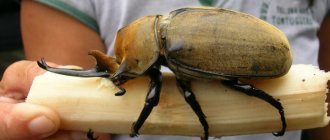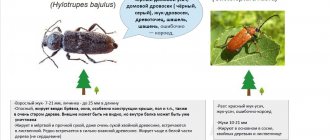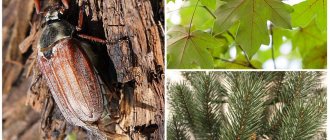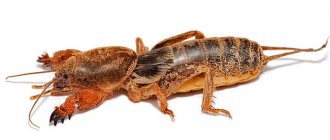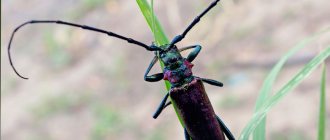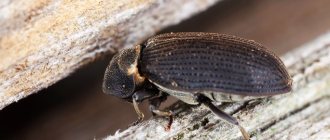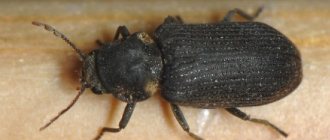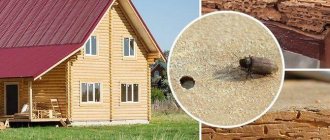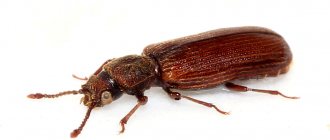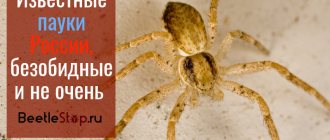Beetle in the house
Fumigation with Phosphine against beetles in the house
Microwave heating of wood against beetles in the house
Insects can appear in any house or apartment, even a very clean one. Moreover, they are almost everywhere - sometimes there are only a few of them, people may not even realize that they have neighbors.
These insects are not always harmful and dangerous, although in large numbers they can cause a lot of trouble. There are also bugs in the house. Which of them can be found in your home and why are they dangerous? In order to get rid of insects from a wooden house, you need to know the enemy by sight.
Are they dangerous?
An unpleasant proximity to this insect threatens with unpleasant consequences of its stay in a person’s home:
- damage to furniture and household items;
- specific immune reactions in a person prone to allergies;
- chew the pile of clothes and carpets, forming holes in the products;
- spread of viral and infectious diseases;
- consequences of a painful bite (they vary from person to person).
Even the pest's excrement is dangerous. If they enter the human body along with food, they can cause an allergic reaction, causing coughing, a feeling of suffocation, redness and a rash on the skin.
The little beetle bites very painfully. The affected area becomes red and inflamed. There is a possibility that bacteria may enter the wound and cause infection.
The bite area must be disinfected with iodine, brilliant green or hydrogen peroxide. Lack of treatment can cause serious inflammation. You should consult a doctor immediately.
Types of bugs in the house
The following types of beetles can be found in houses:
- beetle grinder (furniture, grain, grain, etc.) - damages food supplies, wooden products, wallpaper, etc.;
- springtail - damages indoor plants;
- silverfish - a safe but unpleasant tenant that lives in damp places in the apartment;
- small flour beetle - damages cereals and pasta;
- leather beetle - damages carpets and clothes;
- book louse is a rare guest in apartments, damaging old books and products that contain paste (for example, wallpaper);
- shashel - damages wood;
- bark beetle - damages wood;
- wood-boring beetle - damages wood.
Each type of beetle in the house is worth considering in detail.
Ways to deal with house bugs
Although the exact method can only be determined by knowing the type of beetle, there are a number of principles for protecting your home.
- Find and destroy the nesting site.
- Carry out general cleaning of the premises.
- Check all things that are at risk.
- Carry out temperature effects, if possible.
- Use traditional methods of prevention that repel with smell.
- Sprinkle boric acid or chemicals that will help destroy animals that escaped during harvesting or hatched.
- Some can be caught in special traps, homemade or purchased.
Grinder beetle
This slideshow requires JavaScript.
These beetles pose a serious threat to furniture. They can destroy wooden structures, cardboard, plywood, and books. People believe that grinders are all beetles that harm wood, but they must be distinguished, for example, from the same bark beetles that are fought in other ways.
Borer beetles are a large family of small beetles that may or may not pose a threat to furnishings. Furniture (house) grinders can destroy an entire wooden house. In the old days, they terrified residents with a sound similar to the ticking of a clock - they were even called “death clocks.” The fact is that grinder beetles in large numbers can undermine wooden structures so much that the house collapses, burying people underneath it. They are also capable of destroying expensive wooden furniture, parquet flooring, books, door and furniture frames, picture frames, etc. in a short time. Bread and grain grinders damage not only the corresponding food products, but also spices, books, zoological collections, and herbariums.
grinders in flour
It is easy to suspect the presence of grinders in the house - when gnawing wood, they make a characteristic ticking sound. Externally they are discreet, black or brown, ranging in size from 2 to 9 mm. The body is elongated, cylindrical, the head is tilted down and covered by a protrusion of the pronotum.
Read our article: Ticking sounds and clicks in the house - what to do?
It is necessary to use highly toxic substances in well-ventilated areas. It is important to remember that their use can cause harm to humans through prolonged contact. .
It is much easier to take preventive measures - to treat wood and wooden furniture with special antiseptics that protect the wood from various insects.
Harvest and storage
Harvesting can begin in late September or early October. It is best to store heads of cabbage in the basement, at a temperature not lower than +1 C° and not higher than +5 C°. Otherwise, the cabbage may either freeze or begin to rot.
Valentina cabbage, suspended by the stalk, is very well preserved
Main storage methods:
- on the rack;
- in limbo;
- in boxes.
Some housewives wrap each head of cabbage in paper or cling film, which will help preserve the juiciness of the forks. Before storing, you should carefully check all heads of cabbage and select defective ones. Also, all surface leaves are removed from each of them, leaving 2-3 of them on each fork.
The Valentina F1 variety can be stored for 7 months, and thanks to the good taste and beneficial properties of the head of cabbage, this hybrid is attractive for cultivation in both industrial and private farming.
Long-horned beetle
This slideshow requires JavaScript.
One of the oldest inhabitants on Earth, the long-horned beetle has many varieties. The size of the insect can vary from a few millimeters to several centimeters. Whiskers often exceed body size by 10 times. The larvae reach 3 centimeters in length. In our area, you will most likely encounter a mustachioed black beetle with a green-blue tint. During its development, the longhorned beetle goes through several stages - egg, larva, pupa and, in fact, the beetle.
Longhorned beetle and longhorned beetle species are here!
Review of the best products
Given the wide range of modern insect control products, it is often extremely difficult to make a choice.
To make this process as easy as possible, below is a brief overview of the most effective options:
Aerosol Combat
Containing insecticides such as permethrin and tetramethrin, it is one of the most well-known and effective remedies for home use. It allows you to destroy all types of crawling insects and arthropods, while being able to poison even their eggs and larvae. Combat does not have a pungent chemical odor; instead, a pleasant floral aroma will remain on the treated surfaces. The cost of a can with a volume of 500 ml is about 400 rubles.
Aerosol "Raptor"
It costs less than Combat, but is no less effective. Available in 350 ml cans, the approximate cost is 250 rubles.
Get insecticidal soap
Effectively gets rid of ants, bedbugs and cockroaches. You can even treat carpets with it; the product can then be easily washed off and will not leave stains behind. The approximate price of such soap is 400-420 rubles.
Avalon product
It is an emulsion concentrate from a South Korean manufacturer. The main advantage is the versatility of the solution obtained from it, which destroys all crawling and flying insects and provides protection against them for several weeks. The cost of one 50 ml bottle is about 600 rubles.
Foresight tool
It is also an emulsion concentrate, the main active components of which are cypermethrin and fenthion. First of all, the drug is intended to kill ticks, but it also shows good effectiveness against other crawling insects. The price for it is 350-400 rubles.
Means "Xulat"
Made in Spain, it is intended for preparing a solution based on it. The composition includes various insecticides, which allows you to destroy even insects with developed immunity to certain components. A 30 ml bottle costs about 500 rubles.
Product "Delta Zone"
It is one of the most effective modern remedies, the main active ingredient of which is deltamethrin. A solution based on it shows equally good results in exterminating all types of flying and crawling pests. The cost of a 50 ml bottle is about 700 rubles.
Aerosol "Super Cobra"
Against crawling insects, its quality and effectiveness is confirmed by the fact that it is used by many service specialists for the destruction of these pests. The cost of one bottle is about 230 rubles.
Cucaracha
It is a concentrated liquid preparation that is capable of exterminating all types of insects. The rules for preparing a solution based on it are indicated in the instructions for the product and vary depending on the type of pests being controlled. The price of one bottle is 450 rubles.
Devices emitting ultrasonic waves
They are the most innovative devices for fighting insects. The Belgian-made Weitech WK0523 model, among other things, also affects rodents. The package includes three devices that can be placed in different rooms to increase the area covered by the protective effect. The cost of this equipment is about 4,000 rubles.
Shashel
You can read more about the insect in the article: How to get rid of shashel.
Chashel often refers to beetles that damage furniture. Often all these insects are referred to by one term, although in fact the shashel is a black barbel. Externally, longhorned beetles differ from other grinders in appearance. They are black, with whitish patches, and have a large head with antennae and wings. Body length – 15-40 mm.
The difference between them and other insects that attack wood is that they prefer coniferous trees - fir, spruce. They live mainly in coniferous and pine forests.
The methods of control are the same as with other beetles that damage wood. They love fresh wood and can be found in warehouses, from where they enter homes.
How to get rid of it: effective methods
First of all, you should determine the places where these pests accumulate. Therefore, you will have to look behind the baseboards, examine the furniture in the kitchen, closets with clothes, bookshelves and other places.
It is important to know! This stage requires a serious approach, because soon larvae will emerge from the eggs and then it will be much more difficult to deal with the pest.
After this, you need to decide on the means of struggle. To do this, you need to at least approximately know the degree of infection, as well as the conditions that allow the use of chemical control agents. If expectant mothers, small children, allergy sufferers or frail family members live in the apartment, then it is better to abandon such an idea.
In this case, it is better to give preference to folk remedies, although they are not as effective as chemicals. Often the situation develops in such a way that folk remedies do not cope with the task and one has to resort to the services of special services. This approach will allow you to quickly and reliably get rid of these bugs.
If you decide to fight insects on your own, then you need to be prepared for the fact that this may take more than one day and you will need to find temporary housing, since all family members will have to be evacuated from the apartment, along with pets.
The difficulty of self-processing is as follows:
- It is necessary to process a large area, so it can take a lot of time, without special equipment, and only professionals have it.
- You will have to check all food products, flowerpots, all drawers and all cabinets.
- It is imperative to do a general cleaning, removing old, unnecessary things, and also thoroughly vacuum all places.
- If you can get rid of dusty, dark, secluded places where these insects like to hide, then the task of getting rid of them will be much easier.
How to get rid of beetle larvae
How to remove bugs yourself
If you try hard, you can actually remove such insects on your own, but to do this you will have to do some work. For example:
- Arm yourself with a vacuum cleaner, put a disposable bag - a dust collector, vacuum all carpets and hard-to-reach places, after which it is better to take the carpets out into the sun or frost.
- Boil things in soapy water.
- Items made of leather or leatherette are best treated with chemicals.
- Treat upholstered furniture using a steam generator.
- Items made of wool and artificial materials can also be taken out into the cold.
- Make an audit of food supplies, reviewing everything, especially bulk food products.
- Remove all items from the cabinets where they are stored, after which the cabinets should be disinfected by wiping the inside with a soapy solution.
- Check wooden structures for gaps and cracks. It is better to seal all cracks and cracks with some kind of sealant.
Helpful Tips:
- After preparatory operations, all cracks and crevices in the floor, baseboards, all corners and hard-to-reach places, furniture are treated with either an aerosol or a special solution. It is better not to buy universal drugs, but to select those that are designed to combat harmful bugs. Such drugs exist.
- Treatment is carried out twice a week for one month. This approach allows you to get rid of bugs completely. After treatment, the floors are thoroughly washed and vacuumed.
- Boric acid shows good results in the fight against insects. You can buy the powder at the pharmacy and pour it into all the cracks and cracks. It is in such places that pests hide. Each sachet can contain only 10 g of powder, so you will have to buy several of these sachets. The advantage of boric acid is that it is safe for humans (non-toxic) and for domestic animals, but for many insects it is death, although not immediate. But this does not mean at all that it can be scattered anywhere without getting into it, especially if there are small children in the house. Nothing serious will happen, but diarrhea is guaranteed.
Bark beetle
Read more about it in the article: how to get rid of the typograph bark beetle
These beetles often live in wooden houses, posing a serious danger. These black-brown bugs, no larger than 1 cm in size, gnaw many passages in the wood, destroying the product.
This slideshow requires JavaScript.
They enter the house along with building materials or from neighboring trees. Bark beetle larvae are so voracious that the appearance of just one infected board in a house is enough for them to destroy the entire log house - this will take only a few years.
If single burrows are detected, you can inject special insecticides (“Anti-bug”, “Tree Healer”) directly into the burrows with a syringe, and then cover up the holes. Then all wooden elements of the house should be treated with antiseptics in order to get rid of insects remaining in undetected passages.
If the affected area is large, you need to stick a knife or awl into the damaged area. If the tool enters easily, then the damage is significant. In this case, the affected material must be removed and burned along with the pests. Then treat healthy wood with insecticide and antiseptic and place a new beam in the excavation site. If the wood is strong enough, but the damaged area is large, insecticide treatment should be repeated several times.
Getting rid of bark beetles is quite difficult, so it is better to take preventive measures. First of all, you need to buy proven wood that has been treated with an antiseptic. Also, for the purpose of prevention, it is necessary to periodically treat all wooden elements of the structure (both external and internal) with antiseptics (Senezh, Aquatex, Ecolan, Woodpecker, etc.), and if a lot has passed since the last treatment time - and insecticides.
Reasons for the appearance of bugs
The reasons for the appearance of bugs can be both external and internal factors.
External factors include:
- reduction of the nutrient medium in natural conditions;
- changes in climatic conditions (decrease in temperature and increase in humidity);
- ability to move long distances.
Internal factors can be:
- presence of a nutrient medium in the room;
- comfortable conditions for living and reproduction;
- placing stuffed animals or birds in the apartment;
- storage of a collection of insects (beetles, butterflies);
- home library (especially if you have old tomes);
- presence of pets (especially long-haired ones);
- neglect of preventive measures to combat the skin beetle.
Good to know! The summation of internal and external causes leads to the rapid spread of this pest in residential areas.
wood beetle
A more detailed description in the article: Woodworm - how to get rid of it?
Small, dark bugs with wings are often confused with ordinary, harmless flies. But they can destroy wooden structures in just a few years.
This slideshow requires JavaScript.
They spend almost all their time in the passages they have made inside the wood and fly only during the mating season. That's when you can see them - flying around light bulbs in the evening and crawling on surfaces during the day. The larvae live in wood for up to 17 years, and during this time each one makes passages up to 40 km long in the wood.
To destroy pests, special insecticides are used that are able to penetrate into the treated surface. Light preparations, after spraying onto damaged surfaces, destroy insects on the surface and lure others out of hiding. More powerful preparations quickly destroy even large colonies of pests, but after treatment with them you should not enter the room for several hours - they are toxic.
In order not to have to fight with various beetles that destroy wood, it is better to take preventive measures - the same as in the case of bark beetles.
What kind of bugs are these?
Indoors, the skin beetle prefers to live on the windowsill. This gives him the opportunity to move freely in space and hide the larvae at the bottom of the window sill. The close proximity of heating radiators creates optimal conditions for reproduction.
In addition, a wooden window sill can serve as food for them. Over time, the wood will begin to crumble, turning into dust.
Important! Favorable conditions in a person’s apartment contribute to the rapid proliferation of these beetles. One female is capable of laying up to 100 eggs within 10 days, from which caterpillars emerge after 3 weeks.
The growth period of an insect from egg to adult lasts from six months to a year.
The beetles have an oblong brown or black body covered with coarse hairs. Rigid wings give them the ability to fly. Due to their unremarkable coloring and ability to quickly move in space, they can remain unnoticed for a long time.
Flour beetle
These are small reddish-brown bugs a few millimeters long. They spoil cereals, flour, dried fruits. They usually enter the home along with contaminated products.
If a beetleworm is detected, you must throw away all the stocks of cereals, pasta and dried fruits in the house. These bugs can also live in baseboards and window frames, so after eliminating the products you need to thoroughly rinse all surfaces with a vinegar solution. Skirting boards and other surfaces that do not come into contact with food can be treated with chemicals.
Insect prevention measures
To prevent bugs from entering the house, you need to:
- Do not leave windows open without mosquito nets.
- Seal all cracks in the floor, baseboards, and near pipelines.
- Do not create large reserves of cereals and flour. Store them in a glass container with a tight-fitting lid.
- After bringing bulk products from the store, place them in the freezer for several hours.
Periodic checking of seeds, flour, and dried fruits for the presence of bugs will help to detect them in time and take measures to destroy them.
Carpet beetle
These small bugs gnaw carpets, fur, various natural materials (leather, hide, wool), fabrics, and grain. They pose a danger not only to things, but to people and animals, as they bite painfully and can carry infections and cause allergies. The bite site should be treated with alcohol and hydrogen peroxide.
This slideshow requires JavaScript.
In appearance they resemble grinder beetles. But unlike them, they also pose a threat to humans. Therefore, if they are discovered, it is necessary to take immediate action - it is advisable to call our specialists who are professionally involved in the destruction of insects.
Carpet beetles love dry and warm places, so they are usually found under baseboards near radiators, on window sills, in floor crevices, and cabinets. It is difficult to get rid of skin beetles, so it is better to take preventive measures - for example, putting moth sections in cabinets with the smell of lavender, which they do not like. These bugs also cannot tolerate the smell of tobacco, wormwood, and tansy.
To get rid of skin beetles, you need to use special chemicals . Infected items should be taken out to the balcony - these beetles and larvae die at temperatures below +7 degrees.
Preventative measures for brown bugs
To eliminate brown bugs, it is necessary to carry out extermination and preventive measures.
Such activities are expected to include:
- Carrying out periodic checks for the presence of brown bugs;
- Constant ventilation, especially in winter, with the temperature in the room dropping to 12 degrees;
- Sealing of residential premises, eliminating cracks and possible entry points for pests;
- periodic wet cleaning of premises using special products.
Good to know! Controlling such pests is quite difficult. This is due to their small size, high vitality and omnivorous nature. However, the use of preventive measures, periodic inspection of possible places where pests accumulate and carrying out all methods of destruction will prevent the settlement and spread of small brown bugs.
Book louse
Also called the book hay eater. They have a long body and a large head. They love warmth and high humidity, so if they are detected, it is recommended to reduce the humidity in the room.
Book lice are common in nature - they live in bird nests and rodent burrows. Rarely found in homes - mainly in libraries and museums. These insects feed on plant and animal remains, as well as paste. In the old days they caused a lot of trouble because paste was used in the production of books. They are not interested in modern books, since synthetic glue has begun to be used. They are not dangerous to humans and animals.
The face of the enemy
The carpet beetle is a coleopteran insect. They are black or brown in color, with a body up to 12 mm long and elongated or round in shape. The bug is covered with hairs or scales.
This little parasite multiplies rapidly. And the larvae can live without food for five years.
In nature, skin beetles play the role of a recycler of dust, wool, feathers, and bones of dead animals. These are natural cleaners. Since humans are actively destroying their natural habitat, they have to move into apartments.
Uninvited guests enter houses mainly in the summer through open windows and vents. Also, household members can bring them themselves along with some things - books, carpets, furs, upholstered furniture. The parasite can also hide a newly purchased flower pot.
Carpet beetles are not at all harmless. They are harmful to human health. One bite of a small bug, and the household members have picked up some kind of viral infection or become infected with helminths. A bite can also cause an allergic reaction - unbearable itching in the bitten area.
The parasite must be removed as soon as possible. It is necessary to destroy not only the bugs themselves, but their caterpillars and all larvae.
Silverfish
Silverfish are often confused with woodlice. They have an elongated flat body, with long antennae. Covered with scales, body length up to 19 mm. Safe for humans and animals, but can damage books, clothing and food. They often live in the bathroom, as they love dark and damp places. During the day they prefer to hide in the cracks of baseboards, frames, cabinets, etc.
This slideshow requires JavaScript.
If there are few silverfish in the house, you can try installing a sticky trap - for example, for cockroaches. To attract silverfish, you can put a piece or other starch-containing product inside.
You can also fight silverfish with insecticidal aerosols based on pyrmethrin . It is important to remember that they should not be used in food storage areas. You can also sprinkle diatomaceous earth overnight on areas where silverfish are common, and then vacuum it up. It is important to keep children and animals away from the treated area.
Varieties of black bugs in the apartment
There are many small black beetles in nature, but not all of them are synanthropic insects that have adapted to living with humans in an apartment. Most often in houses you can see beetles, or as they are also called flour beetles, belonging to the darkling beetle family.
Big Khrushchak
These are quite large beetles that live in houses and food warehouses throughout Russia, and look like cockroaches. Their size reaches 1.2–1.8 cm. The flattened body has a black-brown color.
The larvae of the large beetle also do not suffer from their miniscule size and are clearly visible in products. Their length is on average about 2.5 cm. Their shape resembles a yellowish worm with six legs and antennae. They feed on flour, grains, seeds, and dried fruits. They do not refuse wool and other fabrics.
In the apartment, black beetles try to settle closer to food supplies. When there is an abundance of food, they reproduce quickly; the female lays about 200 eggs in one nest, which she makes in a bag of flour. Often even thick plastic packaging does not help. A large flour beetle can chew through them.
Little Khrushchak
This small black insect is very similar to its larger brother. Only it grows to only 3.5 mm. But its wings are well developed, although the beetle does not fly. Males have hairs at the end of their abdomen. Widely distributed in Russia and Ukraine. Adults are able to tolerate low temperatures, but larvae live only in heated rooms.
The black oblong beetles are unusually prolific. One female can lay up to 1 thousand eggs. Moreover, she does masonry not only in products, but also in the crevices of furniture, walls, and floors. This makes pest control difficult. Up to 4 generations of insects can appear per year. The hatched larvae immediately begin to look for a food source. They prefer wholemeal flour, semolina, rice, buckwheat, dried fruits, and nuts.
Black Khrushchak
This insect is slightly larger than a small beetle and reaches a length of 5.5 mm. It is almost impossible to distinguish the larvae without being a specialist.
Black Khrushchak
These small black bugs do not like the cold, so they settle in apartments, shops, heated warehouses and flour mills. In terms of harmfulness, they are not inferior to their counterparts. In addition to cereals, flour and dried fruits, it damages nylon and knitwear. Can eat allspice and glue.
It produces 3–4 generations per year if the habitat has sufficient food supplies and a comfortable air temperature.
Professional extermination of beetles
Various types of beetles can infest homes. It is often quite difficult to determine which type of beetle has settled. Moreover, in each case, the control methods are different - one drug is effective against one type of beetle, the second - against another .
Therefore, if you cannot cope with the beetles on your own, you should contact a specialized insect extermination company - you can see the phone numbers on the page.
Specialists will be able to accurately determine the type of beetles that are bothering the residents of the house and quickly get rid of these insects . Particularly difficult to control are wood-damaging beetles (their species is difficult to pinpoint) and book lice. There is no need to hesitate - even if most beetles do not directly threaten human life, they can cause serious damage to property.
The help of specialists is especially necessary if the beetles have managed to infest the entire house, and complex treatment is required to destroy them. Also, do not hesitate if you suspect that there are carpet beetles in the house - such a neighborhood poses a serious threat to the health of people and animals.
Types of insect repellents
To combat unwanted neighbors, people have developed a large number of different means that have different principles of action.
All the most common varieties are discussed below:
Products available in gel form
They are highly effective because they contain aromatic components that attract the attention of pests and insecticides that have a poisonous effect on them. Gels can infect insects both when they enter the digestive system and through direct contact
However, they do not have any foreign odors, and most options are safe for children and pets.
Aerosol is one of the most effective ways to destroy unwanted neighbors. Such products kill pests faster than many analogues, since poisonous and toxic substances enter their body through the respiratory system. To date, a large number of universal preparations or aerosols have been developed for the extermination of certain species.
Various types of traps that can catch living individuals or destroy their captives. The most common models are those with an adhesive backing; if an insect steps on it, it loses the ability to move. Sticky strips can be suspended from the ceiling to help effectively catch flying species. Another well-known trap is a small house with poisoned bait inside. The pest, having been poisoned by an insecticide, infects its relatives upon contact with them, but such models are effective only against crawling species. An innovative way of combating is the use of universal electric traps, which are equally successful in destroying all species. Death occurs as a result of receiving an electrical discharge, the strength of which is safe for humans.
Folk remedies that abound with various recipes for exterminating household pests. Typically, such methods are time-tested and therefore do not lose their relevance today, even with so many modern drugs and devices.
Various solutions and liquid insecticides. Usually they are diluted with water in accordance with the instructions, after which the premises are treated. There are a large number of substances with varying degrees of toxicity and intended for different types of pests.
Pest danger to humans
The troubles associated with the proximity of a small brown bug for a person are associated with the manifestation of the following negative consequences:
Despite its small size, the bite of a brown bug is quite painful. Each person has their own reaction to such bites. It can cause redness and subsequent inflammation at the bite site. During a bite, pathogenic bacteria can enter the wound and cause infection not only of the bite site, but of the entire body.
Therefore, doctors strongly recommend treating with a disinfectant after detection. This could be hydrogen peroxide, iodine or brilliant green.
